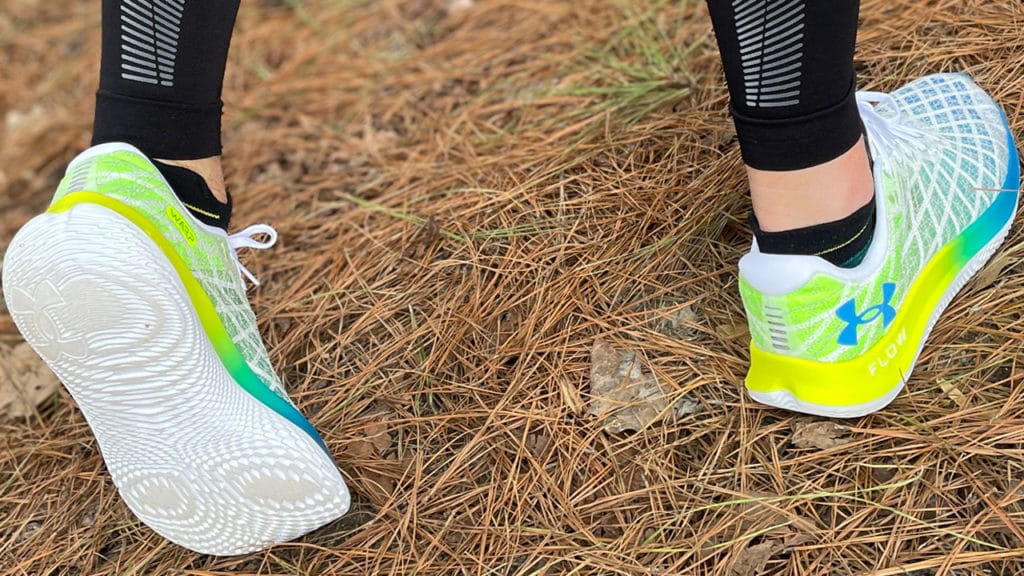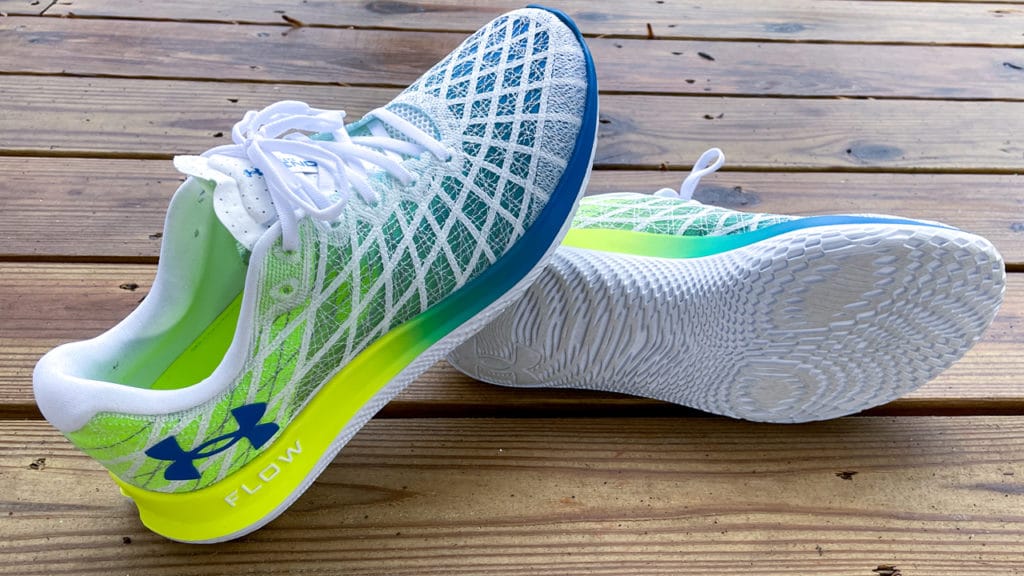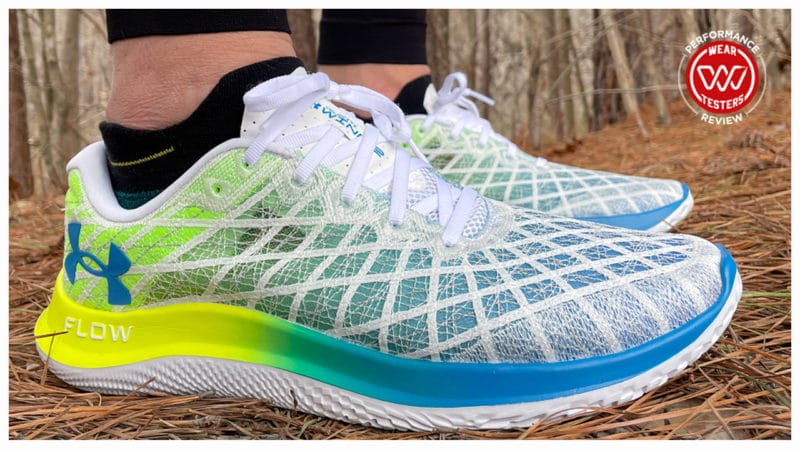The UA Flow Velociti Wind 2 is the second running shoe to utilize Under Armour’s Flow cushioning. Flow was previously featured in the UA Flow Velociti Wind, Curry 8, UA Flow FUTR X and Curry 9. Under Armour previously revealed that the cushion was originally intended for running shoes. But when Steph Curry tried it, he loved it, and told his team to use it on his signature shoe. So that’s why the Curry 8 was the first shoe to utilize the foam and not a running model.
The Flow material makes up both the midsole and outsole thus giving Flow shoes a unique, sleek look. Does Flow work as well on running shoes as basketball shoes? Spoiler alert: YES.
UA Flow Velociti Wind 2
Release Date: February 24, 2022
Price: $160
Weight: 8.5oz
Drop: 8mm (18mm forefoot, 26mm heel)
- Rundown: Quick, responsive shoe that’s great for shorter, faster runs.
Pros
- Flow cushion
- Traction
- WARP upper
Cons
- Same shoe as the original
- Outsole durability
- Price

Pros
Flow Cushion
UA Flow is the star of this particular show. The midsole and outsole are one piece. UA Flow is both the cushion and traction. More on the traction part down below. As for cushion, UA Flow is really good.
The Velociti Wind 2 doesn’t have as thick a slab of Flow as the Curry 8 or 9, so this is not a maximally cushioned shoe. That said, for a shoe with a relatively minimal stack height, the impact protection is superb. Flow really mutes the jarring impact of ground strikes. It protects the foot and saves the knees, ankles, and back. Also, you don’t sink into the foam in a distracting or energy sucking way. The foam compresses to mitigate impact but then you can immediately launch into your next stride. It’s responsive without being too dense. A shoe this responsive can often be too firm but Flow seems to navigate that typical trade off without issue.
All that said, with a stack height of 18mm in the forefoot and 26mm in the heel, it’s just not enough cushion for long runs. I’d keep this shoe at six milers (10K) and under.
Now, I do want to see what happens when they double the stack height of the Flow and give us a maximally cushioned shoe tuned for long runs. I’m crossing my fingers Under Armour has something like that in the pipeline.
Traction
Just like on the Curry models, UA Flow grips surprisingly well outdoors in multiple conditions. It looks exactly like a foam-bottomed shoe but doesn’t wear like one. I also didn’t experience any slippage in wet, rainy, or other iffy conditions. Granted, I couldn’t try them in snow or ice, but the outsole handled everything else without a problem.
A foam bottom that grips this well? It’s not something you see very often.
WARP Upper
The Velociti Wind 2’s upper is a knit, nylon, and mesh upper pattern called WARP. The tongue is a piece of synthetic suede on top that’s gusseted and connected to a mesh ½ bootie. Finally, there’s a ton of padding around the top of the heel. Altogether this upper is really comfy. Supportive, yet also extremely breathable and flexible. Honestly, I think it’s the best running shoe upper ever from Under Armour. It’s a little rough to the touch on the outside but the materials against the feet are plush. It’s definitely a shoe that could pass the all day theme park comfort test.
After a week of runs, the WARP upper feels like a second skin. A very breathable second skin. And as an added bonus, the upper is so lightweight it dries really quickly. That’s helpful if you find yourself running through some snow or rain.

Cons
Same Shoe as the Original
The only differences between the first Velociti Wind and the Velociti Wind 2 are changes to the three logos/overlays on the upper, slimming down the WARP at the toe rand and making the top section of the tongue larger. Nothing else changed. And the small changes they did make have zero effect on performance. That’s disappointing. I’d have liked to see an improved tongue, a higher stack Flow midsole, added outsole rubber or anything that would make it a distinctive second edition. Skeptical the shoes are the same? Watch our YouTube review of the original UA Flow Velociti Wind and compare for yourself.
Outsole Durability
The Flow traction pattern sticks around a lot longer than on other foam-bottomed running shoes I’ve worn in the past. I continue to be surprised at how durable Flow is…but it’s still not as good as most rubbers (blown rubber excepted). I’d like to see future Flow running shoes go the Hoka route and include rubber in high wear areas of the forefoot and heel. In other words, just enough rubber to up the durability significantly.
Price
At $160, the UA Flow Velociti Wind 2 is priced well above its competitors. Flow is new and thus more expensive, but the price makes it hard to recommend the Velociti Wind 2 over similarly nimble competitors like the Hoka Rincon 3. You’re basically paying a $30-40 premium for Flow. But, if you’re an early adopter of shoe technology (like us), that probably won’t surprise you or deter you from buying it.

UA Flow Velociti Wind 2 Summary
The UA Flow Velociti Wind 2 is a nice showcase for Flow cushioning. It’s a quick, responsive shoe that’s great for shorter, faster runs. It proves UA Flow can work well on a running shoe both in terms of impact protection and traction. At $160, the price is high. Definitely an early adopter tax at work. I’m hoping future Flow models will be more reasonably priced. If you’re excited to try Flow and willing to pay for it, you won’t be disappointed.
Thanks to Under Armour for sending pairs to test. Under Armour was not given any editorial control of the review. This review is based on our weartesters’ experiences using the shoes for speed workouts, trail runs, treadmill training, long runs, casual wear, and more.
Pros
- Flow cushion
- Traction
- WARP upper
Cons
- Same shoe as the original
- Outsole durability
- Price




